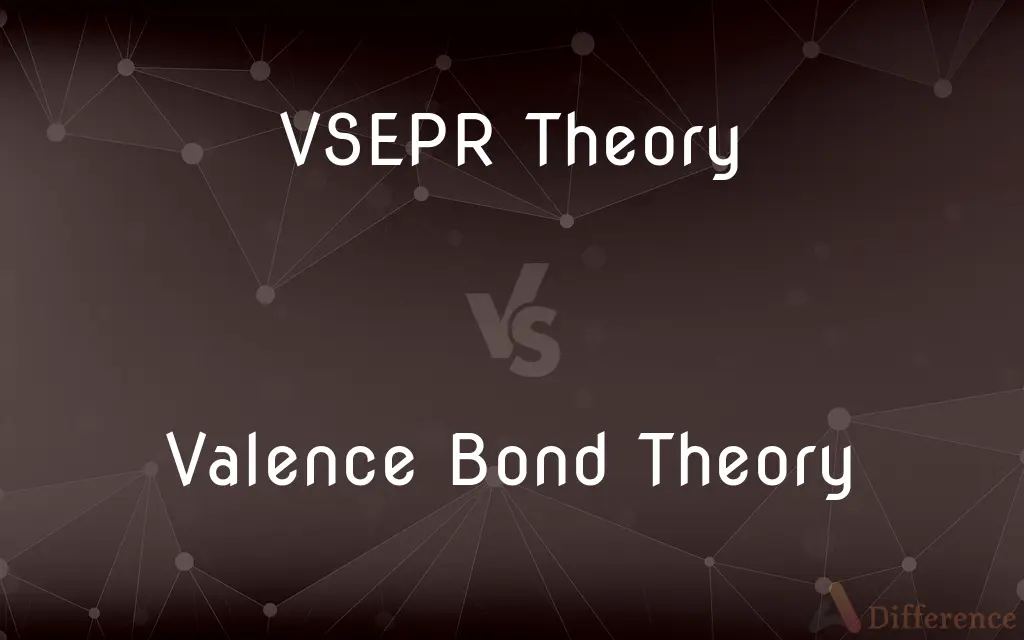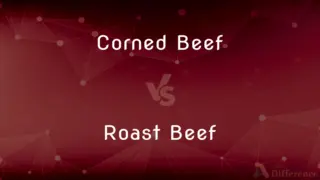VSEPR Theory vs. Valence Bond Theory — What's the Difference?
Edited by Tayyaba Rehman — By Fiza Rafique — Published on December 16, 2023
VSEPR Theory predicts molecular shapes based on repulsions between electron pairs, while Valence Bond Theory explains chemical bonding using overlapping atomic orbitals.

Difference Between VSEPR Theory and Valence Bond Theory
Table of Contents
ADVERTISEMENT
Key Differences
The VSEPR Theory and Valence Bond Theory are both crucial concepts in chemistry that delve into molecular structures and bonds. VSEPR Theory, which stands for Valence Shell Electron Pair Repulsion, primarily focuses on predicting the three-dimensional shape of molecules. This theory posits that electron pairs around a central atom repel each other, and thus, they arrange themselves to be as far apart as possible. By doing so, VSEPR Theory offers insights into the spatial arrangement of atoms in a molecule.
Valence Bond Theory, on the other hand, dives into the nature of chemical bonds themselves. Instead of focusing on the overall shape of a molecule like the VSEPR Theory, Valence Bond Theory looks at how atoms bond by overlapping their atomic orbitals. When atomic orbitals overlap, electrons can be shared between atoms, leading to the formation of a covalent bond.
It's worth noting that while VSEPR Theory is more about the geometrical arrangement of molecules, Valence Bond Theory sheds light on why and how certain atoms bond together. The electron pair repulsions that VSEPR Theory emphasizes lead to the molecular shapes that can then be further explained on a bonding level by the Valence Bond Theory.
In essence, while both theories are centered on electrons and their behaviors, VSEPR Theory is more geometrical, predicting molecular shapes, and Valence Bond Theory is more conceptual, explaining the nature of chemical bonds through orbital overlaps.
Comparison Chart
Main Focus
Predicts molecular shape
Describes chemical bonding
ADVERTISEMENT
Basis
Electron pair repulsions
Overlapping of atomic orbitals
Predictive vs. Descriptive
Predictive of molecular geometry
Descriptive of bond formation
Types of bonds considered
Focuses on non-bonding and bonding electron pairs
Primarily considers covalent bonds
Level of Detail
Provides general shape based on electron repulsions
Gives detailed bonding mechanisms via orbital overlaps
Compare with Definitions
VSEPR Theory
VSEPR Theory provides insight into the spatial arrangement of atoms.
With VSEPR Theory, we can understand why methane is tetrahedral.
Valence Bond Theory
Valence Bond Theory emphasizes the spatial orientation of atomic orbitals.
With Valence Bond Theory, the pi bond in ethene results from the sideways overlap of p orbitals.
VSEPR Theory
VSEPR Theory predicts molecular shapes based on electron repulsions.
Using VSEPR Theory, water has a bent shape due to lone pair repulsions.
Valence Bond Theory
Valence Bond Theory accounts for bond strength and energy.
Valence Bond Theory can explain why a double bond is shorter and stronger than a single bond.
VSEPR Theory
VSEPR Theory encompasses both bonding and non-bonding electron pairs.
VSEPR Theory takes into account the repulsions between bonding and lone pairs in ammonia.
Valence Bond Theory
Valence Bond Theory describes bonding via overlapping atomic orbitals.
Valence Bond Theory explains the formation of a hydrogen molecule through s orbital overlap.
VSEPR Theory
VSEPR Theory offers a geometrical approach to molecular structures.
Using VSEPR Theory, the trigonal planar shape of boron trifluoride can be predicted.
Valence Bond Theory
Valence Bond Theory focuses on covalent bond formation.
According to Valence Bond Theory, two hydrogen atoms share electrons to form a bond.
VSEPR Theory
VSEPR Theory is rooted in minimizing electron pair repulsions.
VSEPR Theory explains the linear shape of carbon dioxide.
Valence Bond Theory
Valence Bond Theory offers a mechanistic view of bond formation.
Valence Bond Theory delves into how the orbitals of nitrogen overlap in forming N2.
Common Curiosities
How does Valence Bond Theory explain a covalent bond?
Valence Bond Theory describes a covalent bond as the overlap of atomic orbitals from two atoms.
Which theory explains molecular polarity better?
While both can address it, VSEPR Theory more directly predicts shapes leading to polarity determinations.
What types of orbitals are considered in Valence Bond Theory?
Valence Bond Theory considers s, p, d, and hybridized orbitals like sp, sp2, and sp3.
What does VSEPR Theory stand for?
VSEPR stands for Valence Shell Electron Pair Repulsion.
Can VSEPR Theory predict the shape of complex molecules?
VSEPR Theory can predict the general shape, but for very complex molecules, advanced methods might be needed.
Why is methane tetrahedral according to VSEPR Theory?
Due to repulsions between its four bonding electron pairs, leading to a tetrahedral arrangement.
Share Your Discovery

Previous Comparison
FET vs. MOSFET
Next Comparison
Corned Beef vs. Roast BeefAuthor Spotlight
Written by
Fiza RafiqueFiza Rafique is a skilled content writer at AskDifference.com, where she meticulously refines and enhances written pieces. Drawing from her vast editorial expertise, Fiza ensures clarity, accuracy, and precision in every article. Passionate about language, she continually seeks to elevate the quality of content for readers worldwide.
Edited by
Tayyaba RehmanTayyaba Rehman is a distinguished writer, currently serving as a primary contributor to askdifference.com. As a researcher in semantics and etymology, Tayyaba's passion for the complexity of languages and their distinctions has found a perfect home on the platform. Tayyaba delves into the intricacies of language, distinguishing between commonly confused words and phrases, thereby providing clarity for readers worldwide.











































